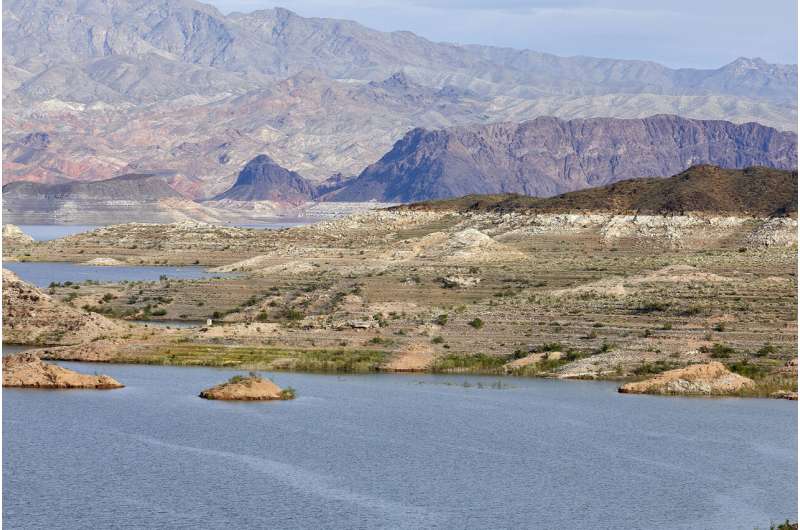Lake Mead. Credit: Josh Hawkins/UNLV
As the climate crisis continues to affect the American West, sunken boats and human remains aren't the only surprises to be revealed by record-low water levels at Lake Mead. Sedimentary rocks that hadn't been seen since the 1930s are now exposed along the constantly changing shoreline, and a UNLV study of the deposits has discovered that many of these rocks also contain ash from volcanoes as far away as Idaho, Wyoming, and California that rained down on Southern Nevada as many as 12 million years ago.
While metropolises located directly in the lava-flow path of active volcanoes tend to receive high attention, the UNLV College of Sciences' Cryptotephra Laboratory for Archaeological and Geological Research (CLAGR) team says explosive volcanic eruptions can have just as critical an impact on the health and safety of populations far from the source.
"Ash from even moderately explosive eruptions can travel hundreds of miles from the source, blanketing entire areas with anywhere from a centimeter to several meters of the heavy material," said Eugene Smith, a UNLV emeritus professor of geology who specializes in volcanology, geochemistry, and geologic mapping and has worked on projects in Africa, Asia, North America, Europe, and Antarctica.
"Although the Las Vegas Valley is currently very far away from any active volcanoes, we can and will have ash from these volcanoes fall over Southern Nevada in the future," Smith said. "Even a couple of millimeters of ash, when wet, is incredibly heavy and can take down power and telecommunications lines. It can block roadways. It is easily remobilized by wind and water. When inhaled, the incredibly tiny but sharp glass grains in the ash can cause significant, chronic lung conditions such as silicosis."
Takeaways
CLAGR researchers used geologic mapping to locate and collect samples of multiple ash layers at Lake Mead and from outcrops just south of Henderson. Back in the lab, the samples were chemically analyzed and then compared to ashes from known volcanic eruptions across the western U.S. to help determine their age and location origin. Among their findings:
- Although the Las Vegas area has hosted volcanic activity over time, scientists determined that the source of the ash layers they found are most likely from outside Southern Nevada because local volcanoes capable of producing explosive eruptions large enough to deposit robust amounts of ash became extinct around 12 million to 13 million years ago.
- The four main possible source areas, each producing distinctive ash, include:
- The Snake River Plain-Yellowstone (SRP-Y) hotspot track, which has been active for the last 15 or so million years. The SRP-Y is a chain of very large volcanic centers that have migrated with time from the northern Nevada/Oregon/Idaho junction, across Idaho, to the active area of Yellowstone National Park near the junctions of Wyoming, Idaho, and Montana.
- The Southwest Nevada volcanic field (SNVF), which was primarily active between 7.5 million and 13 million years ago. This volcanic field is located about 90 miles northwest of Las Vegas and produced about 10 large calderas, or supereruptions, over its lifespan. The proposed Yucca Mountain repository is located just south of one of the calderas.
- Volcanoes of Walker Lake, which is probably more famous for producing large earthquakes in western Nevada and southeastern California, such as the 2019 Ridgecrest and 2020 Monte Cristo Range earthquakes. However, it also contains several large volcanic fields that range in age from 8.5 million years old to presently active. The Long Valley caldera and Mono Craters domes near Bishop, California, are the most well-known because they are still active but extinct 5- to 6-million-year-old volcanoes of the Greenwater Range at the eastern margin of Death Valley in California, as well as one near Silver Peak in central Nevada, also produced explosive eruptions.
- The Ancestral Cascades—the predecessor to the modern Cascade Volcanic Arc—which extends from northernmost California, through Oregon and Washington, and into British Columbia, and includes Mt. St. Helens. Most eruptions from these volcanoes are not explosive enough to distribute ash in Southern Nevada.
- Most of the ash layers the scientists found are between 6 million and 12 million years old, but some are as recent as 32,000 years old—indicating that potential health threats from volcanic activity are ongoing.
Volcanic ash can contain volcanic glass (think of the pumice stones people use to get rid of particularly stubborn foot calluses, but shrunken to almost microscopic size), debris, and crystals from the magma chamber that feeds the eruption. Depending on the size and force of the eruption, the ash, or tephra as geologists call it, can travel hundreds or even thousands of kilometers from the volcano.
One of the most famous examples of volcanic activity in the U.S. was the catastrophic 1980 blast at Mount St. Helens in Washington, which leveled forests, dammed up Spirit Lake, and deposited ash over several states—yet was considered a minor explosive eruption. Larger eruptions that deposit ash farther away can be hazardous to infrastructure such as powerlines, roads, railroads, and buildings, even multiple states away from the volcano itself, the UNLV research team said.
"Studying the past can help you plan for the future," said CLAGR lab manager and longtime Southern Nevada geologist Racheal Johnsen. "The ash layers we study come from volcanoes long extinct. However, studying them has helped us determine just how often the Las Vegas area was inundated with ash over time and may help us prepare for future events from active volcanoes far from us."
More information: DISCOVERY OF ASH IN SEDIMENTS AROUND THE LAS VEGAS VALLEY: IMPLICATIONS FOR FUTURE ASHFALL HAZARDS FROM DISTAL VOLCANOES, Geological Society of America Abstracts with Programs. Vol. 54, No. 2. DOI: 10.1130/abs/2022CD-374326 , gsa.confex.com/gsa/2022CD/webp … ram/Paper374326.html
Provided by University of Nevada, Las Vegas
























